Canning Sweet Potatoes
This post may contain affiliate links, which means that I may receive a commission if you make a purchase using these links. As an Amazon Associate I earn from qualifying purchases.
Sweet potatoes are a favorite side dish during the holidays, but they can also be preserved and enjoyed all year long. By canning sweet potatoes, you’ll have them on hand for all your favorite recipes.

Sweet potatoes are not a crop that we can grow in abundance in our garden every year. We don’t have the space, the warmth, or the full sun the plants require to thrive. However, I do stock up at the fall farmers’ markets and store them in our unheated basement over winter.
Sweet potatoes can last up to eight months if cured and stored properly. But I have learned over the years that it is a good idea to have a backup method for preserving the roots if the curing or storage conditions are off or if I have some leftover once the weather warms in spring.
The sweet potatoes will begin to soften and sprout once dormancy breaks. Once this happens, you’ll need to use them quickly. Simply remove the sprouts and cook them up in your favorite recipes.
But if you find you have an abundance of sweet potatoes still in storage, there are two ways to save them at this point, freezing or pressure canning.
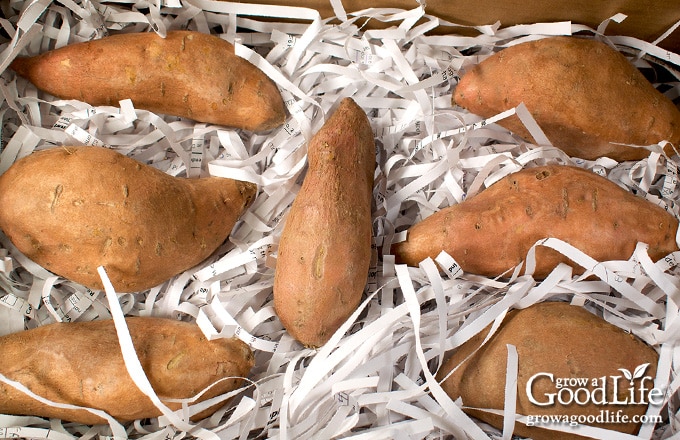
Tips for Canning Sweet Potatoes
Sweet potatoes are a low-acid food that can be home canned safely using a pressure canner. A pressure canner provides a high amount of heat necessary to kill bacteria that can cause botulism. I use a Presto 16-quart pressure canner. Other trusted pressure canner brands include Mirro and All-American.
Plan on about 1 1/4 pounds of sweet potatoes per pint jar and 2 1/2 pounds per quart jar, depending on the size of your pieces. Here are more tips for pressure canning sweet potatoes:
Understand that Canned Sweet Potatoes are Soft
Unlike pressure canning regular potatoes, sweet potatoes will not remain firm after processing. Instead, the preserving process will make them soft. Plan on using your sweet potatoes mashed, pureed, or blended into soups or baked goods.
Use Cured Sweet Potatoes
If you are stocking up on sweet potatoes from the market or grocery store, they have already been cured and are ready to use.
However, if you grow your own sweet potatoes or buy freshly harvested roots from a local grower, you’ll need to cure them before canning. Curing is the process of holding the sweet potatoes in a warm and humid location for a period of time to let the roots convert starch into sugar to improve the texture and sweeten the flavor.
The best way to cure sweet potatoes is to lay them out in a single layer in shallow boxes, cover them with burlap or towels, and place them in a warm and humid location with good airflow, between 80 and 85˚F, and 90% humidity for at least 2 weeks. You can learn more here: How to Harvest, Cure and Store Sweet Potatoes.
Use Syrup to Retain Flavor
You can preserve sweet potatoes in plain water or a syrup made from sugar, honey, or maple syrup. I highly recommend using a syrup mixture for the best flavor. Canning sweet potatoes in syrup will help maintain the quality by preventing the naturally sweet flavor from leeching out of the roots. You can use plain water, but the sweet potatoes will taste bland.
This recipe uses very light sugar syrup, but feel free to substitute any of these options. You can use white sugar or brown sugar:
- Very Light: 6 1/2 cups water and 3/4 cup sugar
- Light: 5 3/4 cups water and 1 1/2 cups sugar
- Medium: 5 1/4 cups water and 2 1/4 cups sugar
- Heavy: 5 cups water and 3 1/4 cups sugar
- Light Honey: 7 cups water and 1/2 cup mild honey
- Maple Syrup: 7 cups water and 1/2 cup maple syrup
Ways to Use Canned Sweet Potatoes
Since canned sweet potatoes are soft, the best way to use them is mashed or purred in soups, casseroles, or baked goods. Most of our jars are heated and mashed for a quick and easy side dish.
Steps for Canning Sweet Potatoes
Before you begin, reviewing this article on Using Pressure Canners at the National Center for Home Food Preservation website may be helpful, along with the instruction manual that came with your pressure canner. Make sure everything is clean and working correctly. Double check that the air vent and steam vent pipe are clear.
You can find the full recipe summary at the bottom of this article. The following steps will show you how to can sweet potatoes.
Step 1: Gather Your Kitchen Equipment
Gather your kitchen tools, and canning equipment, prepare the jars, set up the canner, and organize your work area.
You will need:
- Pressure canner with canning rack
- 8 pint-sized canning jars or 4 quart-sized jars
- Lids and bands (Use new covers for each jar, bands can be reused)
- Canning tools: jar lifter, canning ladle, funnel, and bubble popper
- Basic kitchen supplies include a large stainless steel pot, colander, large prep bowl, tongs, vegetable peeler, knife, cutting board, and clean kitchen towels.
Wash the canning jars, lids, bands, and canning tools in hot soapy water, and rinse well. Set the lids and bands aside to air dry until you are ready to use them.
Place the pressure canner on the stove, and insert the canning rack. Add water per your pressure canner manufacturer’s instructions: Presto is 3 quarts, Mirro is 2 quarts, and All American is 2 to 3 inches.
Warm the jars in the canner by filling them halfway with hot water and then placing them on the rack in the canner. Bring the canner to a simmer for 10 minutes (180˚F). Keep the jars hot until you are ready to fill them.
Step 2: Prepare the Sweet Potatoes
The best quality sweet potatoes for canning are small to medium-sized roots with smooth, undamaged skins that have been cured for 2 weeks or longer.
You will need to peel your sweet potatoes before canning. The best way to peel them is by boiling or steaming until the skins loosen, letting them cool briefly, then slipping the peeling off before cutting the roots into chunks.
Wash the sweet potatoes well under clean running water. Place the roots in a large stainless steel saucepan, cover with water, and bring the pot to a boil over medium-high heat. Cook just until the skins loosen up and wrinkle when rubbed with the tongs, about 10 to 20 minutes, depending on the size of your roots.
You want the sweet potatoes to remain firm. The smaller ones will be ready quicker. Remove once their skins soften, and let the large ones boil longer until they are ready.
Drain the sweet potatoes in a colander discarding the cooking water. Let them cool a bit until you can handle them without burning your hands.

Step 3: Make the Syrup
While the sweet potatoes are cooling, wash out the large pot, and fill it with fresh water and the sweetener of choice. Stir to dissolve the sugar, and bring to a boil over high heat. This syrup is the liquid you’ll use to fill the jars.
If you are not using a sweetened syrup, bring a large pot of plain water to boil over high heat.
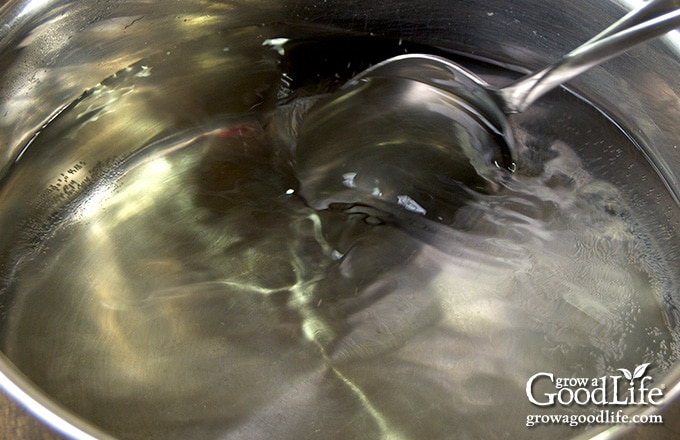
Step 3: Can the Sweet Potatoes
Once the sweet potatoes are cool enough to handle, remove the skins using a knife or vegetable peeler. Cut the roots into uniform 2-inch-sized pieces. Do not mash or puree the sweet potatoes. The pieces must remain in chunks for the heat to penetrate properly. Add the prepared sweet potatoes to a large bowl as you work, and discard the peelings.
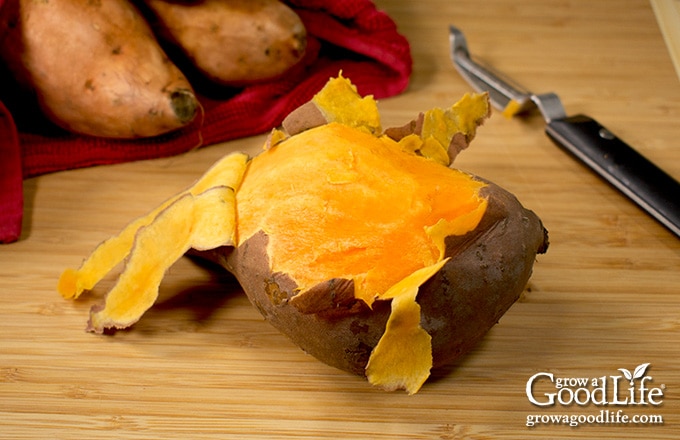
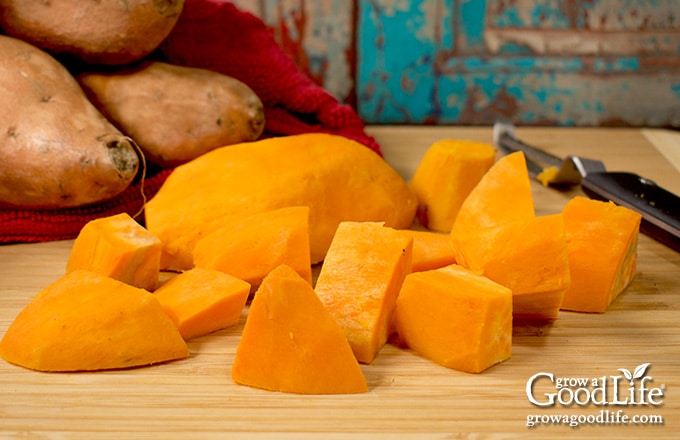
Lay a kitchen towel on the counter. Use the jar lifter to remove a jar from the canner. Pour out the water (save it for washing dishes), and place it on the towel. Keep the remaining jars in the canner so they stay hot.
Using tongs, pack the warm sweet potatoes into the hot jar leaving 1-inch headspace. If you are using salt, add up to 1/2 teaspoon per pint jar and 1 teaspoon per quart jar. Salt is for flavor only, and it is ok to skip.
Use the canning ladle and funnel to fill the jar with hot syrup or boiling water, covering the sweet potatoes while maintaining a 1-inch headspace. Remove air bubbles with the bubble popper, and wipe the rim with a damp towel to remove any sticky residue.
Center a lid on the jar, place the band over the cover, and screw it on until fingertip tight. Immediately place the jar back into the rack in the canner, and repeat with the rest of the jars.
Follow the directions for your pressure canner and process the jars for the times indicated in the recipe below.
When the processing time is complete, turn off the heat and let the canner cool naturally, remove the jars, let them cool completely, and test the seals. Wash the jars, date, label, and store the canned sweet potatoes in a cool location. Use within 12 to 18 months for the best flavor.
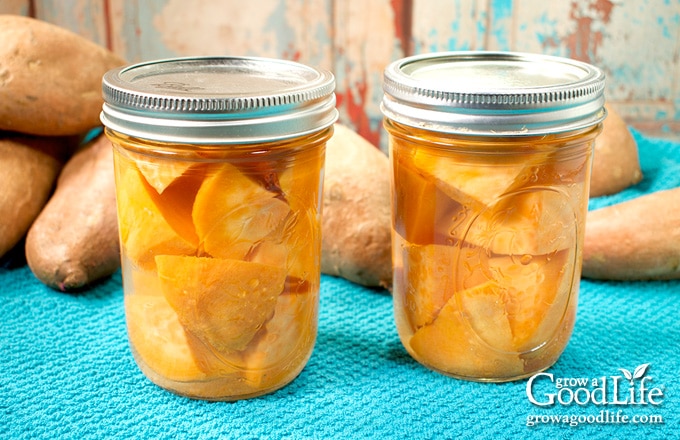
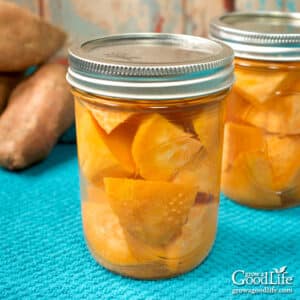
Canning Sweet Potatoes
Ingredients
- 10 pounds sweet potatoes
- 6 1/2 cups water
- 3/4 cups white sugar or brown sugar
- canning salt optional for flavor
Instructions
Prepare the Canning Equipment:
- Wash the jars, canning lids, and rings in hot soapy water and rinse thoroughly. Set the lids and bands aside until you are ready to use them.
- Place the jar rack into the pressure canner, and fill with water per your pressure canner manufacturer’s instructions: Presto is 3 quarts, Mirro is 2 quarts, and All American is 2 to 3 inches.
- Fill the jars halfway with hot water, then place them on the rack in the canner. Bring the canner to a simmer for 10 minutes (180˚F). Keep hot until you are ready to fill them.
Prepare your Sweet Potatoes
- Scrub the sweet potatoes with a vegetable brush and rinse well under running water.
- Add the roots to a large saucepan, cover with water, and bring the pot to a boil over medium-high heat. Cook just until the skins loosen, about 10 to 20 minutes, depending on the size of your roots.
- Drain and discard the cooking water. Let the sweet potatoes cool until you can handle them without burning your hands.
Make the Syrup
- While the sweet potatoes are cooling, wash out the large pot, and place it on the stove.
- Add the water and sugar, and stir to dissolve. Bring the pot to a boil over high heat and keep hot. This syrup will be the liquid you’ll use to fill the jars.
Can the Sweet Potatoes
- Lay a towel on the counter. Use your jar lifter to remove a jar from the canner. Pour out the water (save it for washing dishes), and place the jar on the towel. Keep the remaining jars in the canner so they stay hot.
- Place the canning funnel on the jar and raw pack the sweet potatoes into the jar while leaving 1-inch headspace.
- If you are using canning salt, add up to 1/2 teaspoon salt per pint jar and up to 1 teaspoon per quart jar.
- Ladle boiling liquid over the sweet potatoes, and fill the jar while maintaining a 1-inch headspace.
- Remove air bubbles with the bubble popper, and wipe the rim with a damp paper towel. Make sure all the pieces are submerged and adjust the headspace again if needed.
- Center a cover on the jar, place the band over the lid, and screw it on until fingertip tight. Then, using your jar lifter, immediately place the jar back in the canner, and repeat with the rest of the jars until they are all filled, or you run out of sweet potatoes.
- Place the lid on the canner and lock it. Leave the vent open, adjust the heat to medium-high, and bring the canner to a boil. Allow the pressure canner to vent steam for 10 minutes, place the pressure regulator on top of the air vent, and let the pressure rise.
- Once the canner has reached the correct pressure (10 pounds for weighted gauge and 11 pounds for dial gauge pressure canner), set a timer and process pint jars for 65 minutes and quart jars for 90 minutes at altitudes of less than 1,000 ft.
- Regulate the heat as needed to maintain a steady pressure, and adjust altitude if necessary (see chart below).
- When the processing time is complete, turn off the heat, and let the pressure canner cool down to 0 pressure. Once the canner is depressurized, let the canner cool additional 10 minutes before removing the lid.
- Spread a dry towel on the counter, unlock the cover, and remove it by tilting the lid away from you so that steam does not burn your face.
- Allow another 10 minutes for the jars to adjust to the change in pressure. If the jars are still boiling vigorously, let them sit in the canner for another 5 minutes or until the boiling slows.
- Use the jar lifter to lift jars carefully from the canner and place them on the towel. Keep the jars upright, and don’t tighten bands or check the seals yet. Let the jars sit undisturbed for 12 to 24 hours to cool.
- After 12 to 24 hours, check to be sure jar lids have sealed by pushing on the center. The cover should not pop up. The jar failed to seal if the lid flexes up and down. Refrigerate the jar and use it up within a few days.
- Remove the ring bands, wash, label, date, and store the jars in a cool, dark location (50 to 70 degrees F). Use within 18 months for the best quality—yields about 8 pints or 4 quarts.
Notes
Nutrition
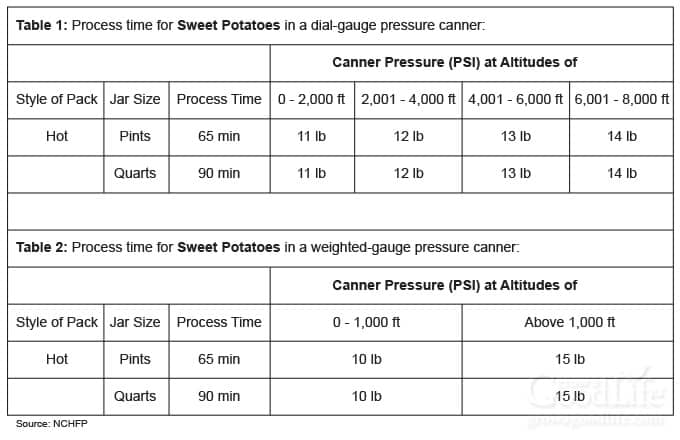
Canning is an excellent option if you’re looking for a way to preserve sweet potatoes to enjoy all year. Home-canned sweet potatoes are ready to use in all your favorite recipes without extra time for peeling and cooking.
You May Also Like:
40+ Meals in a Jar Pressure Canning Recipes
In this eBook, you will find 50 pressure canning recipes, including 44 meals, along with homemade stocks and bone broths. Recipes include soups, stews, chilis, beans, beef, pork, and poultry. Explore the world of preserving delicious home-cooked meals for all seasons.

